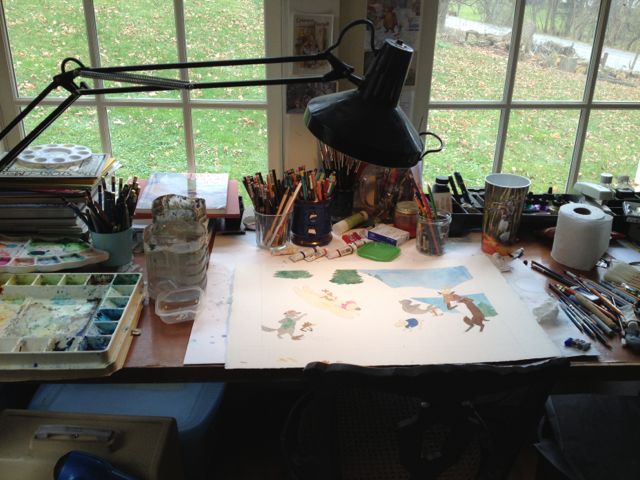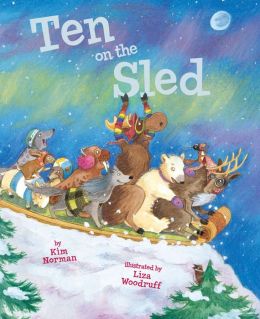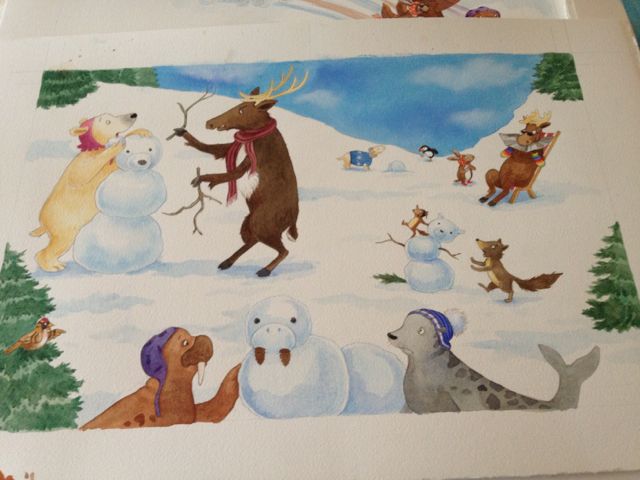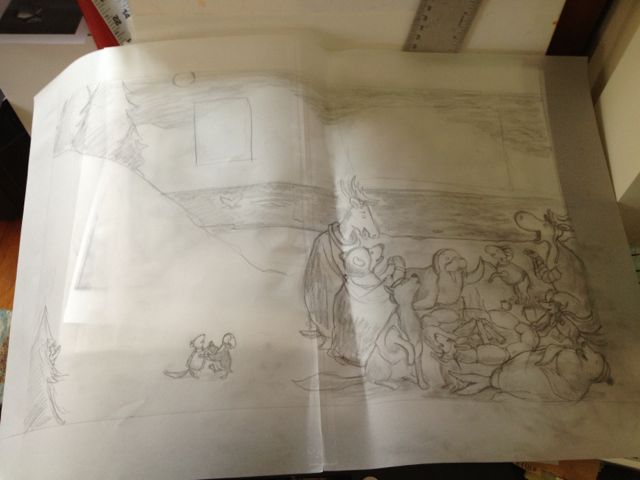My iPod was playing during a long drive to Boston, and somewhere amid Elvis Costello, Graham Parker, Aretha Franklin, Amy Winehouse, Moxy Fruvous, and Yo Yo Ma (don’t you love shuffle?!), I came upon a lecture from Vermont College professor Julie Larios. She was talking about David Almond’s Skellig. Listening to her words brought the fascinating appeal of that novel rushing back. I remembered discovering the book; I’m pretty sure we received advance reading copies and fell in love with its strange magic before publication. David Almond burst onto the American children’s literature scene with that book. And as much as I loved Skellig, I loved Almond’s next novel, Kit’s Wilderness, even more. Skellig is still on kids’ radar because they come across it in schools, but Kit’s Wilderness has all but disappeared – and it was an extraordinary piece of writing and storytelling. Yet, these days, I rarely find myself recommending either book to kids looking for suggestions. Why on earth is that? Why is it that some of my all-time favorite books – some of the most powerful, moving, beautifully written books I’ve come across in children’s literature – get shunted aside for lighter books when I’m handselling to kid readers?
It’s not just that we are busy introducing kids to all the fantastic new books coming down the pike. Even among backlist favorites, I have realized that I often don’t recommend titles I loved. Am I worried about kid appeal? I do recommend scads of older backlist books that I loved as a child: Edward Eager, Eleanor Estes, Julie Andrews Edwards, and all the great award winners and classics that are classics for a reason. I automatically trust my recommendations that come from my childhood reading self. Perhaps I’m less confident that what I discover and love as an adult will translate to today’s child reader. But I don’t think that’s the whole story.
There are many contemporary backlist and midlist titles that are part of my perennial handselling repertoire. But when I stop to think about it, those books are often funny, fantasy, or adventure stories. Partly this is because those are three of my favorite genres. And before I get pelted with tomatoes, let me reassure readers that I am not saying that humor, fantasy, and adventure are less worthy or have less depth than straight dramatic titles; I just suspect that we (or I) may subconsciously perceive them as ‘safer,’ more universal, recommendations than books with more serious themes. Intellectually and from my own experience as a lifelong reader, I know that’s ridiculous. I loved all manner of books as a child, and while I adored books that made me laugh and that delighted my imagination, I treasured the ones that also made me think, that moved me, that gave me windows into other worlds and showed me many ways of navigating human emotion and interaction.
I love these books I sometimes forget or even hesitate to recommend, love them with an abiding passion. In addition to Kit’s Wilderness, I’m talking about books like Francisco X. Stork’s Marcelo in the Real World, Cynthia Voigt’s Homecoming and Dicey’s Song, Nancy Farmer’s A Girl Named Disaster, Markus Zusak’s The Book Thief, Ellen Wittlinger’s Hard Love, M.T. Anderson’s The Pox Party. Is it that a book like Kit’s Wilderness is harder to handsell because it doesn’t have an easy narrative hook, the way fantasy and adventure novels more often do? Is it that the audience for many of these books truly is narrower? Or is it that, given just five minutes with a reader I don’t know well, I’m reluctant to stir those deeper waters?
Whatever the reason, or set of reasons, it is my job to keep beautiful, worthy, wonderful books alive for young readers. That is one of the best possible uses of my time and efforts. So one of my vows this year, one of my real New Year’s resolutions, is to go through 15 years’ worth of Flying Pig newsletters to remind myself of what knocked my socks off — and to bring those books back into the forefront at the store, helping to knock the socks off a whole new generation of readers.
What backlist titles do you love and hold close? Which do you recommend to young readers? And do you ever find yourself holding back? Why?
Monthly Archives: January 2013
They Grew Up So Well
Josie Leavitt - January 9, 2013
At the end of the day yesterday I had two lovely customers come in. They are both high school seniors who have been shopping at the store for all 16 years we’ve been open. One, Sofia, had just been accepted early decision at NYU, and the other, Maryanne, is waiting to hear from about seven colleges.
As I talked with these young women I was struck by how grown up they both were. Each drove to the store themselves, (That kids drive to themselves to the store amazes me. It tickles me every time they come in swinging their keys) and had her own credit card. But more stunning was how grounded these kids were. Sofia and I had a long talk about the relative merits of John Green novels versus David Levithan’s. Of course we had this discussion in the adult section because Sofia, while a lover of YA literature, felt the time had come “…for a book as good as John Green, but for adults.”
When Sofia was 10 she came to our old location and announced she wanted “to be ashed under the bookstore.” As creepy as this sounded, there was something really touching about this. Her love of books was strong; even as a 10-year-old she knew she needed to be surrounded by them. Although why a little kid would be spending so much time thinking about her death is a bit odd, I was touched that she wanted her final resting place to be our store.
When she was about 11, Maryanne came into the old store crying. I approached her gently and asked if she was all right. She said they had just put her cat down and she just wanted to be in with the books and smell them. I let her be for 10 minutes and then we started talking about how much she loved her cat and she left feeling better.
These moments from years ago touch me deeply and I was reminded of that yesterday. We have been privileged to see these kids grow up to young adults. Sofia used to come and just hang out, when her parents were going through a nasty divorce. Maryanne would come in seeking thoughtful recommendations for books for her father. We talked about the colleges they were going to and the insane expense of it. They both asked for jobs.
Wishes for the New Year
Josie Leavitt - January 7, 2013
Today is my first day back at work in two weeks. I must say, the time off has been as restful as it’s been delightful, though sadly, nary a book was read in whirl that was the holidays and catching up with friends. As I ponder the last year I can’t help but think of things I’d like to be different in the coming year. Below is my all-encompassing list of goals/dreams for the bookstore.
– I will try to not lament about the e-readers taking over the book world. Instead, I will celebrate the physical book. I am going to rejoice in the actual book. I love the feel of them, the smell of them, and the portability of them. I will remember that people walking in the door of my store also love the physical book and there is nothing more fun than meeting a kindred spirit.
– To do more school orders. It’s been hard to break into the public school system in my area and it seems to be getting harder, not easier, for indies to provide books to schools. Even the private schools are hesitant “to show favoritism to one store” over another, as we were told by one administrator. I know schools have budgets to adhere to, but in many cases indie stores are the only ones providing free author visits and I’m tiring of fighting for every order. We do have several extremely loyal librarians and teachers who only shop with us, but even they can’t bring the whole school to our store with purchase orders. My goal is simple: get two more teachers per school to order from us in the coming year. If we can slowly build that way, perhaps come September we’ll be awash in orders.
– Keep better inventory control. I say this every year and every year it gets better, but this is the area that all of us could improve on. Processing returns faster is always a goal, however it always seems to be the law that the minute a hardcover nonfiction political book gets returned, someone suddenly comes in wanting it. Murphy’s Law aside, I think I need to take a more harsh approach to returns and not hang on to books that I hope will sell, eventually, but just return them.
– Make smarter frontlist orders. I say this every year, too, but every year this is a challenge. Do I need to buy every picture book with an adorable bear story? No. Do I? More often than I care to admit. The hard part with frontlist ordering is guessing, to some degree, what the hot books will be and ordering enough of them.
– Read more. This probably pops up on every bookseller’s list, but it is always a goal for me to just spend more time reading. The issue with this is there just aren’t always enough hours in the day.
– Get more creative with displays and signage. I often delegate this to staffers, who do a great job and I’m thankful for them. But I sometimes wish I could come up with really clever displays that make people laugh as they linger over them. This might be a lofty goal for me as I always joke that were it not for Elizabeth, we’d have the exact same display we had when we opened 16 years ago.
– Lastly, have more fun at work.
Booksellers, what are your goals for the coming year?
Clap Your Paws! A Visit to Liza Woodruff’s Studio
Elizabeth Bluemle - January 3, 2013
 Before the holidays, I had a chance to have tea with my friend, children’s book illustrator Liza Woodruff. I love visiting with Liza. Not only does she always have THE funniest misadventures to share, but she’s a great cook and her house is lovely: bright, colorful, cheery and restful, all at once. And she’s got some adorable pets: dogs, guinea pigs, and chickens.
Before the holidays, I had a chance to have tea with my friend, children’s book illustrator Liza Woodruff. I love visiting with Liza. Not only does she always have THE funniest misadventures to share, but she’s a great cook and her house is lovely: bright, colorful, cheery and restful, all at once. And she’s got some adorable pets: dogs, guinea pigs, and chickens.

 The new book is called, If It’s Snowy and You Know It, Clap Your Paws! I got a sneak peek at the text and it’s just as much fun to read aloud as the first. This one is a twist, of course, on the perennial little-kid favorite song, “If You’re Happy and You Know It, Clap Your Hands.” Kim Norman is really, really good at reworking these popular tunes in fresh ways, and Liza’s art is the perfect tonal complement.
The new book is called, If It’s Snowy and You Know It, Clap Your Paws! I got a sneak peek at the text and it’s just as much fun to read aloud as the first. This one is a twist, of course, on the perennial little-kid favorite song, “If You’re Happy and You Know It, Clap Your Hands.” Kim Norman is really, really good at reworking these popular tunes in fresh ways, and Liza’s art is the perfect tonal complement.
Seeing the art in progress was a huge treat. I love the little watercolor worlds Liza creates in her books, especially her winter worlds. They are cozy and inviting, happy places. Her animals have individual, quirky personalities complete with anxieties and passions. They are hilarious. If you look closely at the animals in Ten on the Sled, whole mini-stories unfold in the art. (The polar bear and the caribou, for example, have a sweet little innocent love story. Cracks me up.) To my mind, Liza and fellow Vermont illustrator Sarah Dillard (Perfectly Arugula) have this unusual ability to take less-often-explored personality traits (for example, over-enthusiasm, or perfectionism) and making them funny and lovable.
 I love talking with children’s illustrators about their work. I love how they think and visualize and problem-solve. Seeing someone’s artistic process spread out in sketches and finished paintings reminds me that every single line on the page is a conscious decision an artist has to make against a blank page. Of course that’s obvious, but it’s easy to forget when looking at paintings bursting with life and vibrancy. Writers also face the blank page — but, perhaps because I don’t have that artistic facility and ability, an artist’s blank page seems emptier, more daunting. I greatly admire and envy (in the purest possible way) an artist’s ability to envision something and actually render it on the page. To me, it is actual magic in addition to hard work, practice, skill, and even a little genius.
I love talking with children’s illustrators about their work. I love how they think and visualize and problem-solve. Seeing someone’s artistic process spread out in sketches and finished paintings reminds me that every single line on the page is a conscious decision an artist has to make against a blank page. Of course that’s obvious, but it’s easy to forget when looking at paintings bursting with life and vibrancy. Writers also face the blank page — but, perhaps because I don’t have that artistic facility and ability, an artist’s blank page seems emptier, more daunting. I greatly admire and envy (in the purest possible way) an artist’s ability to envision something and actually render it on the page. To me, it is actual magic in addition to hard work, practice, skill, and even a little genius.


